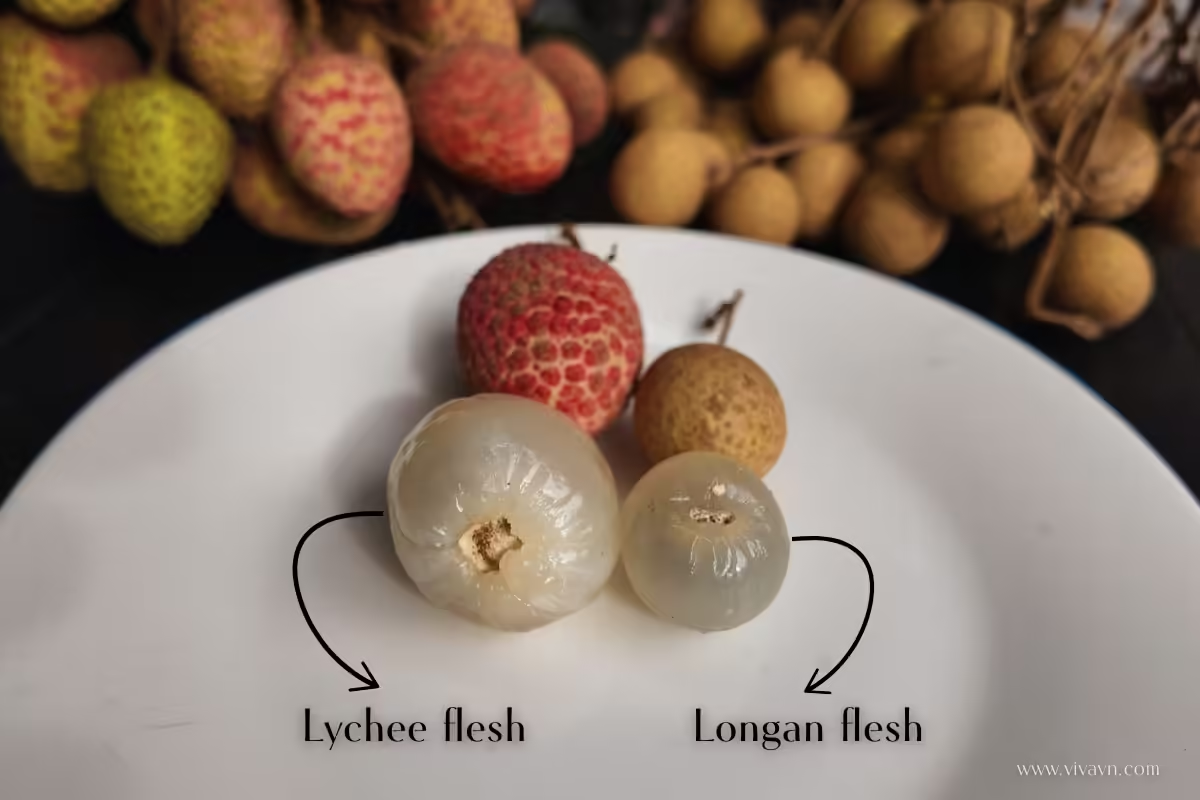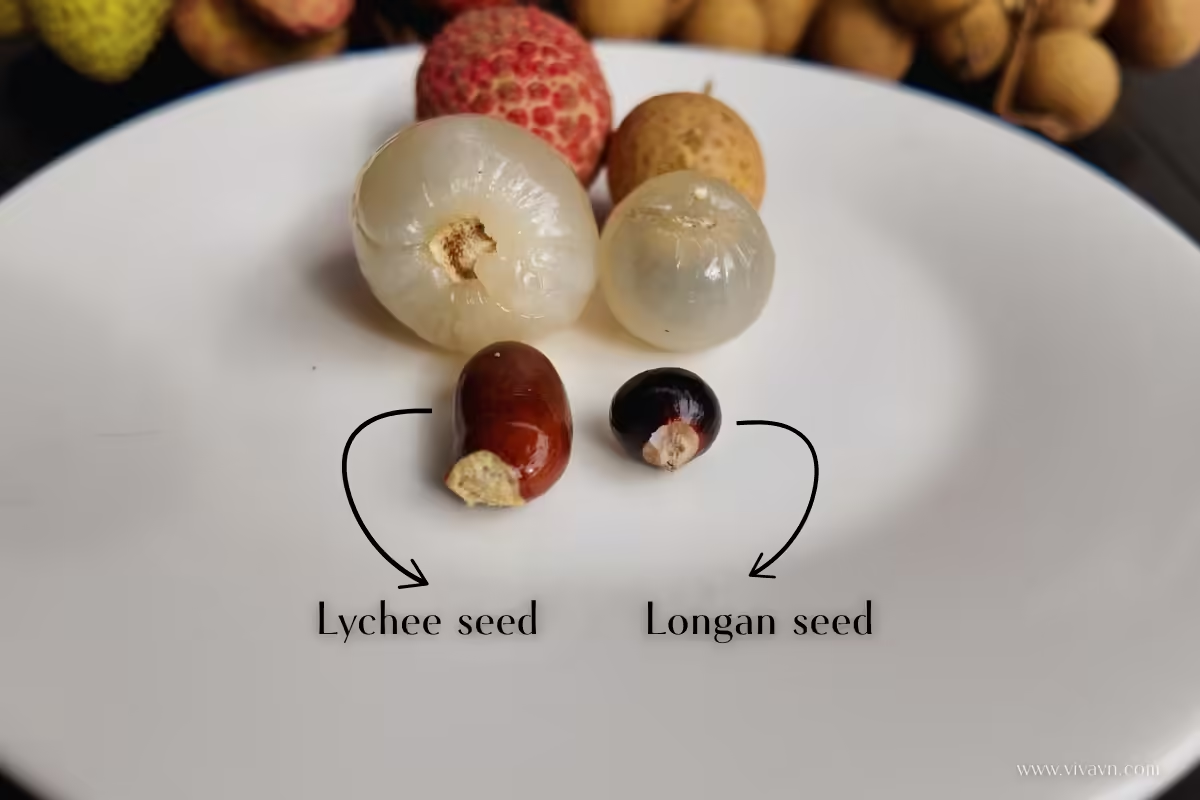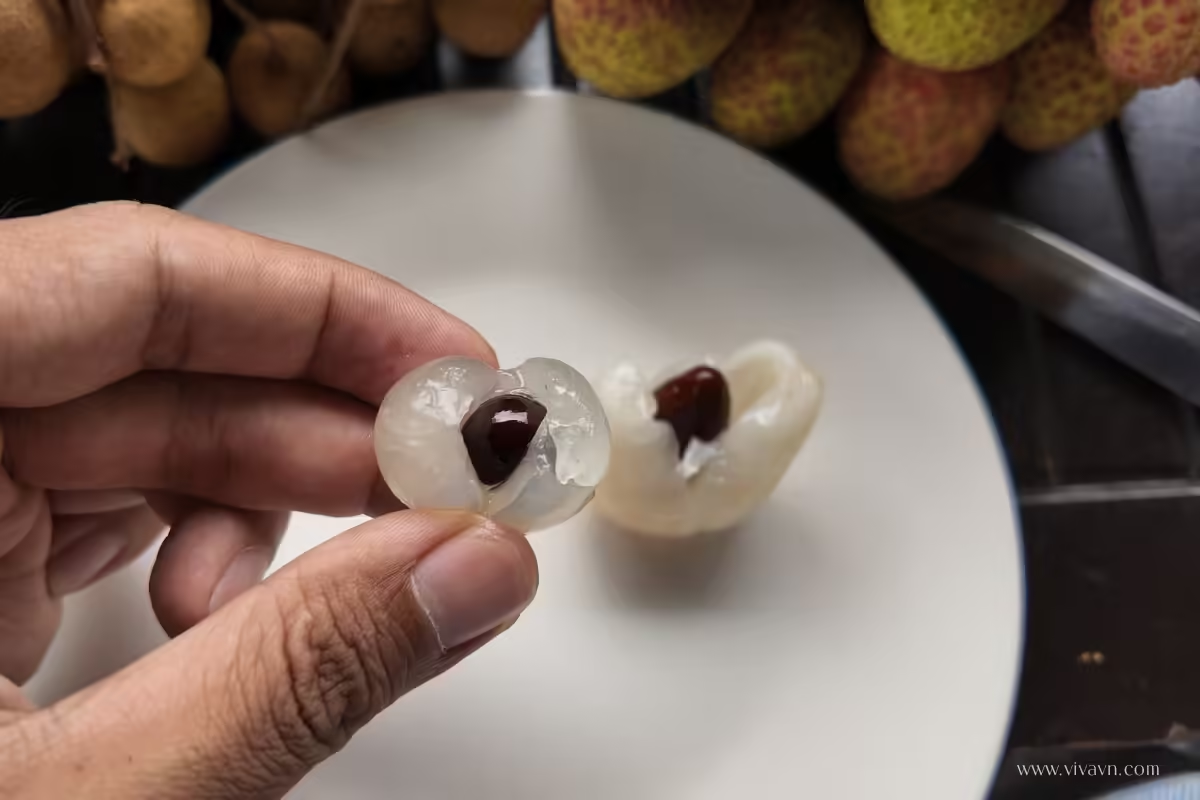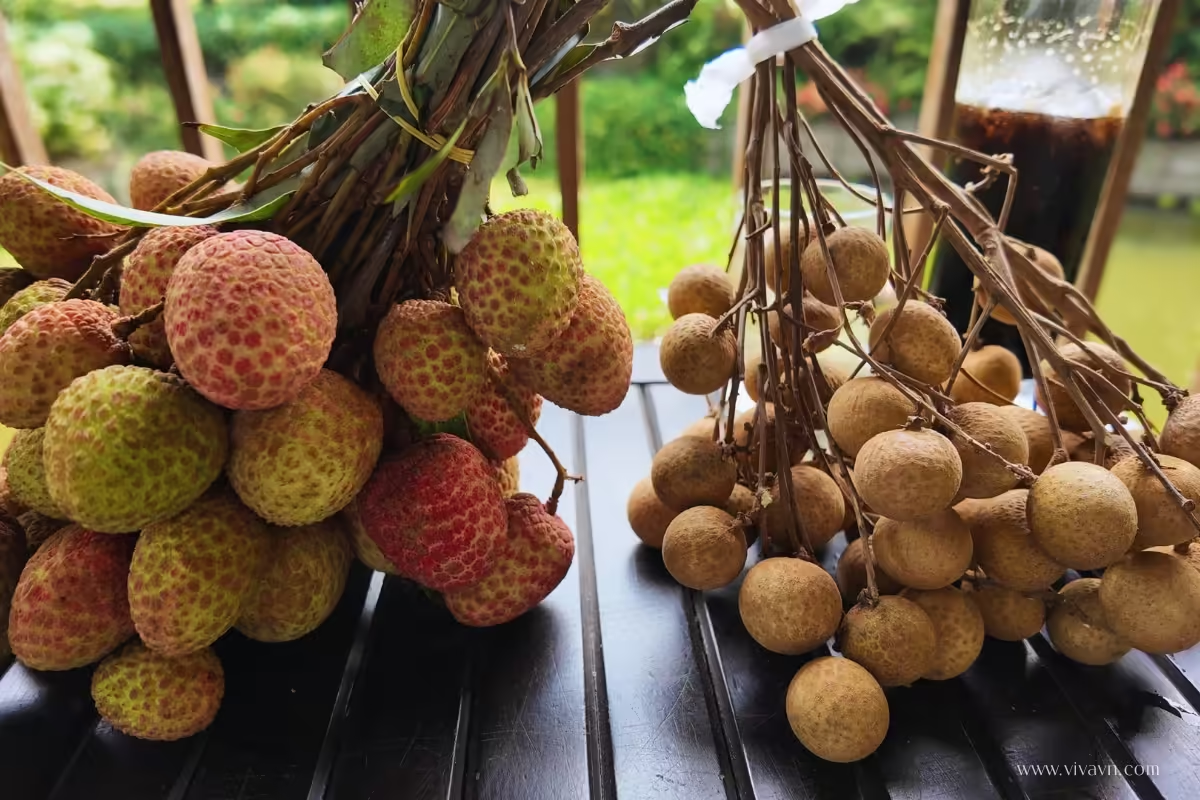
Lychee vs Longan: What’s the Difference?
Lychee and longan may grow in similar climates and share tropical roots, but their differences are easy to spot once you know what to look for. In this article, we’ll compare lychee vs longan in detail, covering their appearance, flavor, nutrition, and their roles in Vietnamese cuisine and traditional medicine.
Quick comparison
What is lychee
What is longan
Shared traits
Key differences
Nutrition comparison
Culinary and medicinal uses
FAQs
Quick comparison table (for easy skimming)
Scientific Name
Size
Skin
Flesh
Seed
Flavor
Aroma
Peak Season in Vietnam

Lychee
Litchi chinensis
Larger
Rough, bumpy, pinkish-red
Juicy, soft, slightly opaque
Brown, glossy, and oblong
Sweet, floral, with a refreshing tang
Light and fragrant
Early to mid-summer

Longan
Dimocarpus longan
Smaller
Smooth, light brown, with tiny dark dots
Crispier, more translucent
Black, glossy, and round
Sweet, mild, with a subtle musky aftertaste
Mild with a warm, musky note
Mid to late summer
What is lychee?
Lychee (Litchi chinensis), called “vai” or “vai thieu” in Vietnamese, is a tropical fruit known for its sweet, floral flavor and juicy, jelly-like texture. It has a rough, pinkish-red skin that you peel away to reveal translucent white flesh and a shiny brown seed inside.
Our detailed article: Lychee: The Exotic Vietnamese Fruit That’s Bursting with Flavor

Macro close-up of lychee fruit showing its bright red, rough, and bumpy skin texture.
What is longan?
Longan (Dimocarpus longan), called “nhan” or “long nhan” in Vietnamese, is a small, round tropical fruit. Often called the “dragon’s eye” due to its translucent flesh and dark seeds, the longan belongs to the same family as the lychee and rambutan. It has a thin, light brown shell that’s easy to peel, revealing juicy, white flesh inside.
Our detailed article: Vietnamese Longan: All You Need to Know About This Fruit

Macro close-up of longan fruit showing its light brown, smooth, and slightly speckled skin.
What lychee and longan have in common
Lychee and longan are often compared — and for good reason. Both are tropical fruits native to Asia, part of the soapberry family (Sapindaceae), and packed with juicy, sweet flesh that’s refreshing. When peeled, they look quite similar: white flesh surrounding a shiny seed at the center.
They’re also both summer fruits and are often enjoyed fresh, added to desserts, or used in Asian drinks and sweet soups. Nutritionally, lychee and longan are low in fat, hydrating, and a good source of vitamin C and antioxidants.

Fresh half-cut lychee and longan fruits side by side, showing peel, flesh, and seed layers for easy comparison
Key differences between lychee and longan
Appearance comparison
At first glance, lychees and longans are easy to tell apart. Lychees are noticeably larger than longans and have a rough, bumpy skin that ranges from pink to red, covered in small, raised nodules that give it a distinct textured appearance. Longans, on the other hand, are smaller and have smooth, light brown skin that’s often speckled with tiny dark dots, giving them a lightly freckled look.

Whole lychee (left) and longan (right), showing the differences in outer skin texture, color, and size
Flesh comparison
Both fruits have translucent white flesh, but with subtle differences. Lychee flesh is thicker, juicier, and slightly more opaque. It feels soft and tender when you bite into it. Longan flesh is a bit firmer and more translucent, sometimes allowing you to see the seed through the fruit. It has a slightly crisper texture compared to lychee.

A side-by-side comparison of peeled lychee and longan fruits.
Seed comparison
The seeds are another key difference. Lychee seeds are usually long, shiny, and brown in color. Longan seeds are smaller, round, and black with a glossy surface.

Lychee seed and longan seed side by side, showing differences in shape and color
Taste comparison
Both fruits are sweet, but they offer distinct flavor profiles and textures. Lychee is juicy and sweet, with a light floral aroma and a gentle tang that feels refreshing and bright. It’s juicier than longan and has a clean, delicate scent without any musky notes. Longans are also sweet, with a juicy texture that carries just a bit of crispness. Longans don’t have any tangy or sour notes—just pure sweetness with a subtle musky aftertaste that lingers on your tongue.

Close-up of fresh, juicy lychee flesh

Close-up of fresh longan flesh
Nutrition comparison: lychee vs longan

When it comes to nutrition, both lychee and longan are refreshing, low-fat fruits that offer some valuable health benefits. While the USDA provides a wide range of detailed nutrient data for each fruit, here we focus on some key nutrients that highlight their similarities and differences.
Here’s a quick side-by-side comparison based on data from the USDA entry for lychee and USDA entry for longan:
| Nutrient | Lychee (per 100g) | Longan (per 100g) |
|---|---|---|
| Vitamin C | 71.5 mg | 84 mg |
| Energy | 66 kcal | 60 kcal |
| Carbohydrates | 16.5 g | 15.1 g |
| Water | 81.8 g | 82.8 g |
| Total lipid (fat) | 0.44 g | 0.1 g |
| Potassium | 171 mg | 266 mg |
| Fiber | 1.3 g | 1.1 g |
| Iron | 0.31 mg | 0.13 mg |
| Protein | 0.83 g | 1.31 g |
Longan has slightly fewer calories and carbs than lychee, but it offers more potassium and protein. It’s also a slightly better source of vitamin C. On the other hand, lychee contains more fiber and iron. Both fruits are hydrating and make excellent additions to a healthy, fruit-rich diet.
How lychee and longan are used in Vietnamese cuisine and traditional medicine
Lychee and longan in Vietnamese cuisine
Both lychee and longan are popular ingredients in Vietnamese cooking, especially in traditional desserts and beverages. They are often combined with lotus seeds to make sweet soups (che), a beloved treat during warmer months.
Additionally, lychee and longan are commonly brewed with oolong tea and sweetened with sugar to create refreshing fruit-infused teas. To extend their shelf life and enhance flavor, both fruits are frequently dried, allowing them to be enjoyed year-round.

A refreshing glass of Vietnamese lychee tea made with fresh lychee fruit, oolong tea, jelly, and ice.
Lychee and longan in Vietnamese traditional medicine
Note before we begin:
These uses of lychee and longan come from traditional Vietnamese folk remedies passed down through generations. While people still enjoy and believe in their benefits today, these practices are not supported by modern medical research. So, consider them cultural insights rather than scientifically proven medical advice.
In Vietnamese traditional medicine, various parts of lychee and longan—including the peel, seed, and flesh—are valued for their healing properties. Fresh or dried lychee flesh is traditionally used to relieve fatigue, both mental and physical, and is believed to help ease muscle soreness, particularly in the shoulders and lower back.
Longan flesh, on the other hand, can be used alone or blended with other herbs to formulate remedies aimed at boosting energy, enhancing memory, and combating signs of skin aging.
FAQs about lychee and longan
What is the main difference between lychee and longan?
Lychee has rough, pinkish-red skin and juicier, softer flesh with a floral, slightly tangy flavor. Longan has smooth, light brown skin and crisper flesh with a mild, musky sweetness.
How can I tell lychee and longan apart by their appearance?
Lychee is larger with rough, bumpy, pinkish-red skin, while longan is smaller with smooth, light brown skin covered in tiny dark dots.
Are lychee and longan from the same plant family?
Yes, both belong to the soapberry family (Sapindaceae) and share tropical origins in Asia.
Can I eat the seeds of lychee or longan?
No, the seeds of both fruits are not edible and should be discarded.
Share on FacebookShare on X (Twitter)Share on PinterestShare on WhatsappShare on LinkedinShare on TelegramShare on Email
- https://www.youtube.com/@VivaVNOfficial
- https://www.facebook.com/vivavnofficial2024
- https://www.pinterest.com/vivavnofficial/
© 2025 VivaVN. All rights reserved.


Leave a Reply